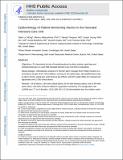Epidemiology of patient monitoring alarms in the neonatal intensive care unit
Author(s)
Matsushima, Minoru; Timpson, Wendy; Young, Susan; Miedema, David; Gupta, Munish; Li, Taibo,M. Eng.Massachusetts Institute of Technology.; ... Show more Show less
DownloadAccepted version (411.3Kb)
Terms of use
Metadata
Show full item recordAbstract
Objective: To characterize the rate of monitoring alarms by alarm priority, signal type, and developmental age in a Level-IIIB Neonatal Intensive Care Unit (NICU) population. Study design: Retrospective analysis of 2,294,687 alarm messages from Philips monitors in a convenience sample of 917 NICU patients, covering 12,001 patient-days. We stratified alarm rates by alarm priority, signal type, postmenstrual age (PMA) and birth weight (BW), and reviewed and adjudicated over 21,000 critical alarms. Results: Of all alarms, 3.6% were critical alarms, 55.0% were advisory alarms, and 41.4% were device alerts. Over 60% of alarms related to oxygenation monitoring. The average alarm rate (±SEM) was 177.1 ± 4.9 [median: 135.9; IQR: 89.2–213.3] alarms/patient-day; the medians varied significantly with PMA and BW (p < 0.001) in U-shaped patterns, with higher rates at lower and higher PMA and BW. Based on waveform reviews, over 99% of critical arrhythmia alarms were deemed technically false. Conclusions: The alarm burden in this NICU population is very significant; the average alarm rate significantly underrepresents alarm rates at low and high PMA and BW. Virtually all critical arrhythmia alarms were artifactual.
Date issued
2018-05Department
Massachusetts Institute of Technology. Institute for Medical Engineering & ScienceJournal
Journal of Perinatology
Publisher
Springer Nature
Citation
Li, Taibo, et al. “Epidemiology of Patient Monitoring Alarms in the Neonatal Intensive Care Unit.” Journal of Perinatology, 38, 8 (August 2018): 1030–38.
Version: Author's final manuscript
ISSN
0743-8346